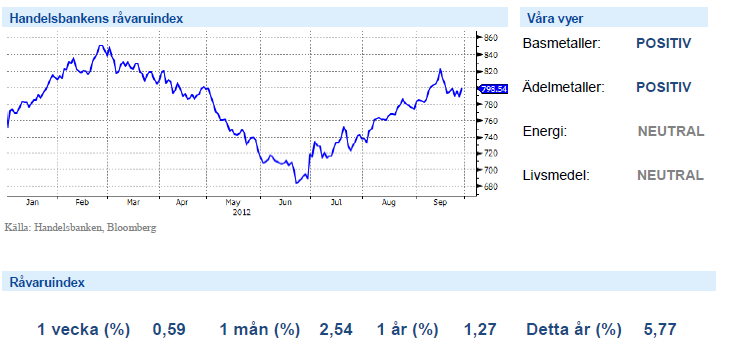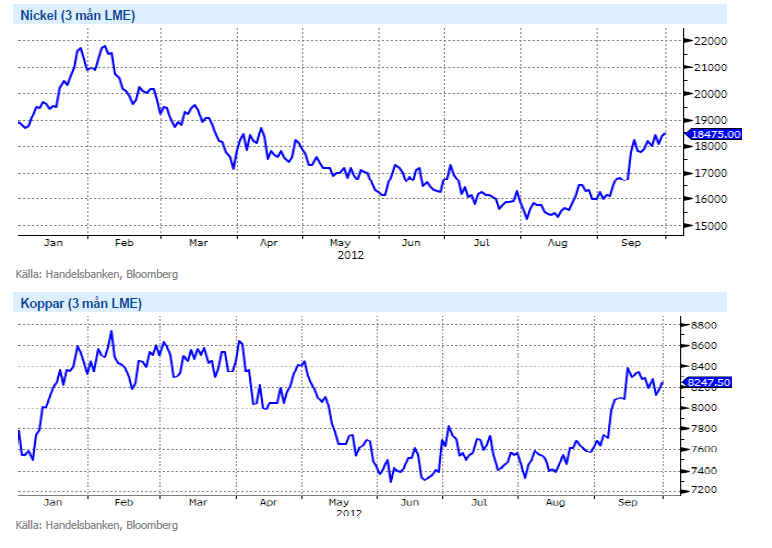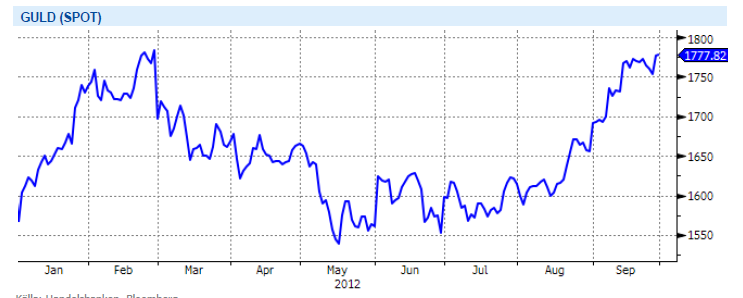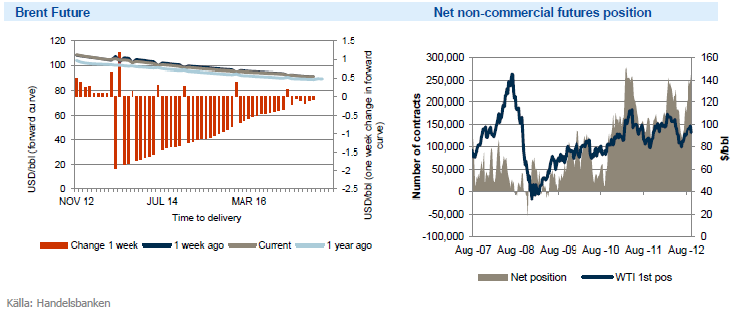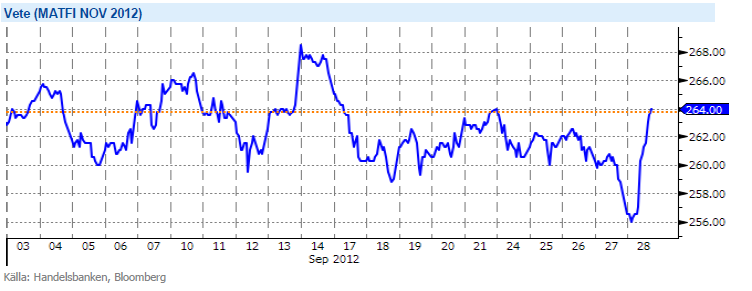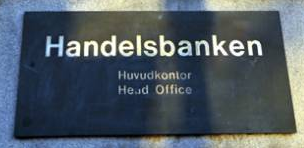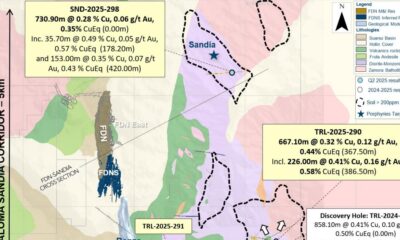Analys
SHB Råvarubrevet 28 september 2012
 Råvaror Allmänt
Råvaror Allmänt
Marknaden präglas av baksmälla
Under de senaste två veckorna får marknaderna sägas ha präglats av baksmälla efter augusti och septembers ”centralbanksorkestrerade obligationsköparpartaj”. Det hör inte till ovanligheterna att optimismen kommer av sig strax efter att nya stimulansprogram lanserats.
Så var det efter den officiella lanseringen av QE2, och så har det blivit även efter QE3, trots att den har ett ”öppet slut”. De individuella skillnaderna mellan de olika råvarorna börjar växa fram när marknaden inte enbart präglas av ”risk on/ risk off” handel. Mycket riskpremie har pyst ur oljan men ädel- och basmetaller håller emot.
Basmetallerna
Nickel visar på styrka
Resultatet efter veckans handel på basmetaller är något blandat där tenn och nickel är vinnare med en uppgång på 3% respektive 1,8%. Nickel handlas nu på nivåer vi inte sett sedan mitten av april och vi tror att trenden för nickel kommer fortsätta under hösten.
En ny ryktesflora av stimulanser kom ut under veckan. Denna gång riktade mot infrastruktur. Kinas makrodata har ännu inte vänt uppåt men spotpriset för de kinaexponerade metallerna har vänt skarpt uppåt de två senaste veckorna och indikerar att någonting håller på att hända i Kina. Ett negativt koppararbitrage mellan Shanghai och LME brukar i normala fall hålla Kineserna borta från spotmarknaden på metall och koncentrat så intressant att se om detta kan komma att pressa LME eller om Kineserna upprätthåller den höga importnivån av koncentrat (+14.4 YoY fram till september), metallerna avslutar i alla fall veckan väldigt starkt inför ”Golden Week” helgdagarna.
En ny ryktesflora av stimulanser kom ut under veckan. Denna gång riktade mot infrastruktur. Kinas makrodata har ännu inte vänt uppåt men spotpriset för de kinaexponerade metallerna har vänt skarpt uppåt de två senaste veckorna och indikerar att någonting håller på att hända i Kina. Vi tror på: BASMET H
Ädelmetaller
”Buy the rumour – sell the fact”
De två veckor som passerat sedan Fed annonserade QE3 har bjudit på en ganska lugn ädelmetall-marknad. Guldet har stigit med 5 dollar per uns, silver är i stort oförändrat medan platina fallit med 3 %. En viss känsla av den klassiska devisen ”buy the rumour – sell the fact” har smugit sig in, i den meningen att den stora prisuppgången i ädelmetaller ägde rum från det att Fed antydde ytterligare stimulanser till dess att de faktiskt annonserade dem.
Ytterligare oroligheter och strejker i Sydafrikan-ska gruvor har stängt ner produktionen motsvarande 40 % av landets totala kapacitet. Den senaste tidens oroligheter i platina-gruvor har lett till lönehöjningar i den delen av gruvnäringen, och detta riskerar leda till att man vill se samma lönehöjningar i guldgruvorna. Därför bör det finnas risk att strejkerna inom guldgruvorna sprider sig vidare i ett kort perspektiv.
Sydafrika är en stor nation inom guldproduktion, men inte alls så dominant som den varit historiskt. 1970 stod Sydafrika för nära 70 % av världens guldproduktion, en andel som successivt fallit till dagens 7 %. Största enskilda producentnation idag är Kina, följt av Australien och USA.
Även om det fysiska produktionsbortfallet i Sydafrika är signifikant, så tror vi att prisuppgången framöver kommer att drivas primärt av den penningpolitiska stimulans som världens största centralbanker just nu bjuder på.
Centralbankernas maniska kampanjer för att få fart på den globala ekonomin gynnar de ädla metallerna. Utöver stöd från centralbankerna så tilltar också utbudsstörningarna i Sydafrikas Platina och guldgruvor. Sammantaget är det en stark bild för ädelmetallerna. Vi tror på: ADELMET H
Energi
Välbalanserad fundamenta
Oljepriset halkade under USD 110/bbl tidigare i veckan på fördjupad oro kring Europa och amerikan-ska vinstvarningar. Irans kommentarer kring sina kärnanläggningar i kombination med överraskande amerikanska lagerminskningar balanserar nedgången något även om det senare passerade relativt obemärkt kan tyckas (totalt -3.41 miljoner fat), en effekt av minskad import snarare än ökad efterfrågan. Under det senaste prisfallet tycker vi att mycket av riskpremien kring konflikten mellan Israel och Iran har pyst ut. WTI oljan har historiskt sett tydligt påverkas av QE perioder medan effekten är mycket mindre på Brent. I närtid tycker vi att fundamenta är väl balanserat och håller oss neutrala.
Fundamenta håller nere elpriset och elmarknaden handlar i stort sett oförändrat över veckan där kvartalskontraktet Q1 2013 var nere och vände under 40 euro nivån som hastigast. Inledningsvis vått och milt väder i kombination med låga spottar som verkade för nedsidan, men i takt med stigande fossila bränslepriser, tysk el, och utsläppsrätter samt torrare varsel handlades kontraktet upp till förra veckans stängningsnivåer. Utsläppsmarknaden stöds av EU Kommissionens skepsis mot möjligheterna att använda krediter från de länder som inte vill skriva under Kyoto 2 protokollet. Även kolmarknaden ser ut att finna ett visst stöd men detta på väldigt låga nivåer så fokus förblir fortsatt på vädret om det ska till någon kraftig rörelse. Senaste väderprognosen visar på normal nederbörd om ca 6 TWh de kommande 10 dagarna vilket därmed bör hålla energibalansen kvar kring nuvarande nivåer om + 12 TWh. Fokus kommer successivt flyttas mot den kallare årstiden och därmed kommer kärnkraften åter att diskuteras. Just nu står 4,5 av våra tio reaktorer helt stilla och det finns en klar risk inför vintern men just nu ser vädret ut att hålla nere marknaden ett tag till.
Fundamenta håller nere elpriset även om fokus successivt flyttas mot den kallare årstiden och därmed kommer kärnkraften åter att diskuteras. Just nu står 4,5 av våra tio reaktorer helt stilla och det finns en klar risk inför vintern. Vi avvaktar dock att marknaden ska vända före vi tror på starkt stigande elpriser.
Livsmedel
USDA rapport överraskade
USA vetet fortsätter sin resa nedåt i den fallande kanal som Chicago har handlats i de senaste 11 veckorna. Fallande majs är det huvudsakliga skälet till att vete är svagt. Det har pratats/spekulerats mycket kring att efterfrågan på det amerikanska vetet ska bli stark under den kommande export/importperioden världen över, främst som en konsekvens av sämre export från svarta havsregionen. Före det händer verkar dock inte vete få mycket stöd kring nuvarande nivåer. Frankrike har överraskat och ökat exporten. Samtidigt har de höga priserna i Ryssland gjort att exporten där hr minskat och det verkar som att Ryska politiker kan låta prismekanismen sköta lagersaldot i år.
Fallet för majs kan nu summeras till 1,20 USD/bu se-dan toppen i augusti. Fallande export i USA på nuvarande priser och det säsongsmässiga trycket nedåt på priserna mitt under skörden är de viktigaste faktorerna bakom prisfallet. Det finns säkert skäl för USDA att se över sina estimat på USA export, givet senaste tidens svaga export.
Få nyheter på sojamarknaden denna vecka men den starka trenden nedåt för sojan har fått EU:s rapspris att vända söderut. Raps har fallit 40 EUR på två veckor, vilket motsvarar 8 %. Detta är fortfarande mindre än de 11 % som sojan tappat under samma period och trycket nedåt på rapspriset i Paris kan därför bestå. Kommande vecka är semestervecka i Kina och spannmålsbörserna där är stängda och kommer inte att ge någon vägledning för USA och Europa.
Dagens USDA rapport för det tredje kvartalet 2012 var något överraskande och marknaden reagerar starkt mot slutet där Vete handlas upp på två veckors högsta nivå (se nedan). Lagersiffrorna på både Vete och Majs kom in en bra bit under våra och marknadens förväntningar, 2,104 miljoner bushels för Vete (162 miljoner under förväntan) och 988 miljoner bushels för Majs (178 miljoner under förväntan) samtidigt som Sojalagren visar 169 miljoner bushels 39 miljoner över förväntan.
Handelsbankens Råvaruindex
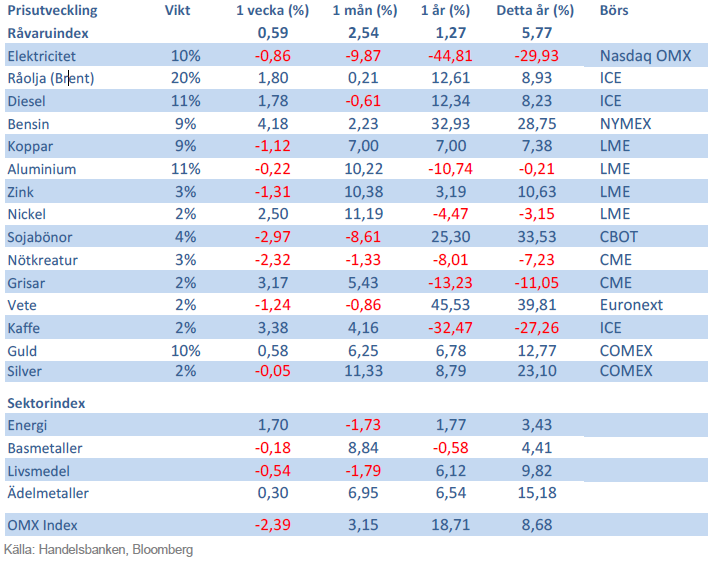
Handelsbankens råvaruindex består av de underliggande indexen för respektive råvara. Vikterna är bestämda till hälften från värdet av global produktion och till hälften från likviditeten i terminskontrakten.
[box]SHB Råvarubrevet är producerat av Handelsbanken och publiceras i samarbete och med tillstånd på Råvarumarknaden.se[/box]
Ansvarsbegränsning
Detta material är producerat av Svenska Handelsbanken AB (publ) i fortsättningen kallad Handelsbanken. De som arbetar med innehållet är inte analytiker och materialet är inte oberoende investeringsanalys. Innehållet är uteslutande avsett för kunder i Sverige. Syftet är att ge en allmän information till Handelsbankens kunder och utgör inte ett personligt investeringsråd eller en personlig rekommendation. Informationen ska inte ensamt utgöra underlag för investeringsbeslut. Kunder bör inhämta råd från sina rådgivare och basera sina investeringsbeslut utifrån egen erfarenhet.
Informationen i materialet kan ändras och också avvika från de åsikter som uttrycks i oberoende investeringsanalyser från Handelsbanken. Informationen grundar sig på allmänt tillgänglig information och är hämtad från källor som bedöms som tillförlitliga, men riktigheten kan inte garanteras och informationen kan vara ofullständig eller nedkortad. Ingen del av förslaget får reproduceras eller distribueras till någon annan person utan att Handelsbanken dessförinnan lämnat sitt skriftliga medgivande. Handelsbanken ansvarar inte för att materialet används på ett sätt som strider mot förbudet mot vidarebefordran eller offentliggörs i strid med bankens regler.
Analys
Breaking some eggs in US shale

Lower as OPEC+ keeps fast-tracking redeployment of previous cuts. Brent closed down 1.3% yesterday to USD 68.76/b on the back of the news over the weekend that OPEC+ (V8) lifted its quota by 547 kb/d for September. Intraday it traded to a low of USD 68.0/b but then pushed higher as Trump threatened to slap sanctions on India if it continues to buy loads of Russian oil. An effort by Donald Trump to force Putin to a truce in Ukraine. This morning it is trading down 0.6% at USD 68.3/b which is just USD 1.3/b below its July average.

Only US shale can hand back the market share which OPEC+ is after. The overall picture in the oil market today and the coming 18 months is that OPEC+ is in the process of taking back market share which it lost over the past years in exchange for higher prices. There is only one source of oil supply which has sufficient reactivity and that is US shale. Average liquids production in the US is set to average 23.1 mb/d in 2025 which is up a whooping 3.4 mb/d since 2021 while it is only up 280 kb/d versus 2024.
Taking back market share is usually a messy business involving a deep trough in prices and significant economic pain for the involved parties. The original plan of OPEC+ (V8) was to tip-toe the 2.2 mb/d cuts gradually back into the market over the course to December 2026. Hoping that robust demand growth and slower non-OPEC+ supply growth would make room for the re-deployment without pushing oil prices down too much.
From tip-toing to fast-tracking. Though still not full aggression. US trade war, weaker global growth outlook and Trump insisting on a lower oil price, and persistent robust non-OPEC+ supply growth changed their minds. Now it is much more fast-track with the re-deployment of the 2.2 mb/d done already by September this year. Though with some adjustments. Lifting quotas is not immediately the same as lifting production as Russia and Iraq first have to pay down their production debt. The OPEC+ organization is also holding the door open for production cuts if need be. And the group is not blasting the market with oil. So far it has all been very orderly with limited impact on prices. Despite the fast-tracking.
The overall process is nonetheless still to take back market share. And that won’t be without pain. The good news for OPEC+ is of course that US shale now is cooling down when WTI is south of USD 65/b rather than heating up when WTI is north of USD 45/b as was the case before.
OPEC+ will have to break some eggs in the US shale oil patches to take back lost market share. The process is already in play. Global oil inventories have been building and they will build more and the oil price will be pushed lower.
A Brent average of USD 60/b in 2026 implies a low of the year of USD 45-47.5/b. Assume that an average Brent crude oil price of USD 60/b and an average WTI price of USD 57.5/b in 2026 is sufficient to drive US oil rig count down by another 100 rigs and US crude production down by 1.5 mb/d from Dec-25 to Dec-26. A Brent crude average of USD 60/b sounds like a nice price. Do remember though that over the course of a year Brent crude fluctuates +/- USD 10-15/b around the average. So if USD 60/b is the average price, then the low of the year is in the mid to the high USD 40ies/b.
US shale oil producers are likely bracing themselves for what’s in store. US shale oil producers are aware of what is in store. They can see that inventories are rising and they have been cutting rigs and drilling activity since mid-April. But significantly more is needed over the coming 18 months or so. The faster they cut the better off they will be. Cutting 5 drilling rigs per week to the end of the year, an additional total of 100 rigs, will likely drive US crude oil production down by 1.5 mb/d from Dec-25 to Dec-26 and come a long way of handing back the market share OPEC+ is after.
Analys
More from OPEC+ means US shale has to gradually back off further

The OPEC+ subgroup V8 this weekend decided to fully unwind their voluntary cut of 2.2 mb/d. The September quota hike was set at 547 kb/d thereby unwinding the full 2.2 mb/d. This still leaves another layer of voluntary cuts of 1.6 mb/d which is likely to be unwind at some point.

Higher quotas however do not immediately translate to equally higher production. This because Russia and Iraq have ”production debts” of cumulative over-production which they need to pay back by holding production below the agreed quotas. I.e. they cannot (should not) lift production before Jan (Russia) and March (Iraq) next year.
Argus estimates that global oil stocks have increased by 180 mb so far this year but with large skews. Strong build in Asia while Europe and the US still have low inventories. US Gulf stocks are at the lowest level in 35 years. This strong skew is likely due to political sanctions towards Russian and Iranian oil exports and the shadow fleet used to export their oil. These sanctions naturally drive their oil exports to Asia and non-OECD countries. That is where the surplus over the past half year has been going and where inventories have been building. An area which has a much more opaque oil market. Relatively low visibility with respect to oil inventories and thus weaker price signals from inventory dynamics there.
This has helped shield Brent and WTI crude oil price benchmarks to some degree from the running, global surplus over the past half year. Brent crude averaged USD 73/b in December 2024 and at current USD 69.7/b it is not all that much lower today despite an estimated global stock build of 180 mb since the end of last year and a highly anticipated equally large stock build for the rest of the year.
What helps to blur the message from OPEC+ in its current process of unwinding cuts and taking back market share, is that, while lifting quotas, it is at the same time also quite explicit that this is not a one way street. That it may turn around make new cuts if need be.
This is very different from its previous efforts to take back market share from US shale oil producers. In its previous efforts it typically tried to shock US shale oil producers out of the market. But they came back very, very quickly.
When OPEC+ now is taking back market share from US shale oil it is more like it is exerting a continuous, gradually increasing pressure towards US shale oil rather than trying to shock it out of the market which it tried before. OPEC+ is now forcing US shale oil producers to gradually back off. US oil drilling rig count is down from 480 in Q1-25 to now 410 last week and it is typically falling by some 4-5 rigs per week currently. This has happened at an average WTI price of about USD 65/b. This is very different from earlier when US shale oil activity exploded when WTI went north of USD 45/b. This helps to give OPEC+ a lot of confidence.
Global oil inventories are set to rise further in H2-25 and crude oil prices will likely be forced lower though the global skew in terms of where inventories are building is muddying the picture. US shale oil activity will likely decline further in H2-25 as well with rig count down maybe another 100 rigs. Thus making room for more oil from OPEC+.
Analys
Tightening fundamentals – bullish inventories from DOE

The latest weekly report from the US DOE showed a substantial drawdown across key petroleum categories, adding more upside potential to the fundamental picture.

Commercial crude inventories (excl. SPR) fell by 5.8 million barrels, bringing total inventories down to 415.1 million barrels. Now sitting 11% below the five-year seasonal norm and placed in the lowest 2015-2022 range (see picture below).
Product inventories also tightened further last week. Gasoline inventories declined by 2.1 million barrels, with reductions seen in both finished gasoline and blending components. Current gasoline levels are about 3% below the five-year average for this time of year.
Among products, the most notable move came in diesel, where inventories dropped by almost 4.1 million barrels, deepening the deficit to around 20% below seasonal norms – continuing to underscore the persistent supply tightness in diesel markets.
The only area of inventory growth was in propane/propylene, which posted a significant 5.1-million-barrel build and now stands 9% above the five-year average.
Total commercial petroleum inventories (crude plus refined products) declined by 4.2 million barrels on the week, reinforcing the overall tightening of US crude and products.
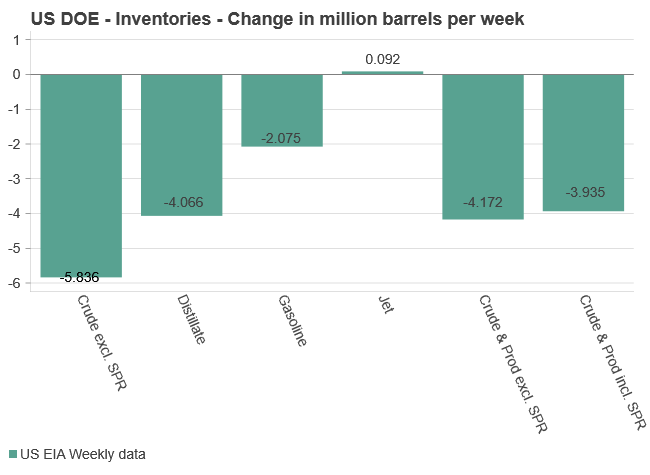

-

 Nyheter4 veckor sedan
Nyheter4 veckor sedanUSA ska införa 50 procent tull på koppar
-

 Nyheter3 veckor sedan
Nyheter3 veckor sedanUSA inför 93,5 % tull på kinesisk grafit
-

 Nyheter2 veckor sedan
Nyheter2 veckor sedanFusionsföretag visar hur guld kan produceras av kvicksilver i stor skala – alkemidrömmen ska bli verklighet
-

 Nyheter3 veckor sedan
Nyheter3 veckor sedanWestinghouse planerar tio nya stora kärnreaktorer i USA – byggstart senast 2030
-

 Nyheter2 veckor sedan
Nyheter2 veckor sedanRyska militären har skjutit ihjäl minst 11 guldletare vid sin gruva i Centralafrikanska republiken
-

 Nyheter3 veckor sedan
Nyheter3 veckor sedanEurobattery Minerals förvärvar majoritet i spansk volframgruva
-

 Nyheter1 vecka sedan
Nyheter1 vecka sedanKopparpriset i fritt fall i USA efter att tullregler presenterats
-

 Nyheter3 veckor sedan
Nyheter3 veckor sedanKina skärper kontrollen av sällsynta jordartsmetaller, vill stoppa olaglig export


